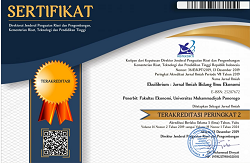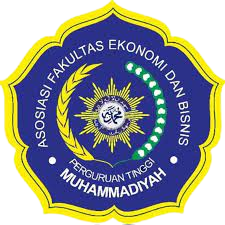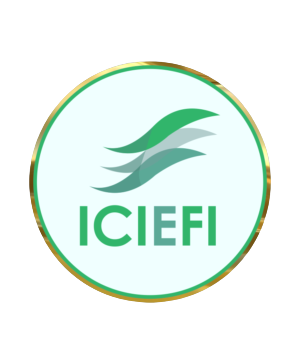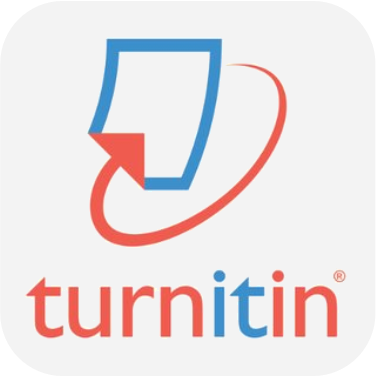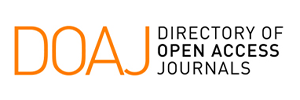Quality Improvement Efforts of DGT’s Internal Compliance Unit (Study at Yogyakarta Small Tax Office)
DOI: 10.24269/ekuilibrium.v19i1.2024.pp92-106
Abstract
The Internal Control System is implemented in the organization as a prevention of fraud risk. The Directorate General of Taxes (DGT) already has an Internal Compliance Unit (hereinafter referred to as UKI) as the vanguard in internal control efforts. However, there are still cases of fraud and Hand-Arrest Operations at the DGT that have questioned the quality of UKI. This study aims to find the constraints experienced by UKI in carrying out internal control monitoring tasks as well as efforts that can be made to improve the quality of UKI. This research method is qualitative with a case study at the Yogyakarta Small Tax Office (STO). The types of data used are primary data and secondary data. Primary data is obtained directly from observations and interviews with informants in the field, while secondary data comes from documents, regulations, and data previously published to data users. The analysis technique was carried out by grouping data, coding, and then presenting a visualization of the results using NVivo 12 plus software. The results of the study found that the ways to improve the quality of UKI at STO are adhering to the Annual Monitoring Plan (RPT) guidelines, increasing the knowledge and soft skills of UKI staff, increasing the use of technology, segregating UKI duties and responsibilities.
Keywords
References
- Anur, C.M. (2022). Ini Instansi yang Paling Banyak Terjerat Kasus Korupsi sejak 2004. Katadata. https://databoks.katadata.co.id/datapublish/2022/11/03/ini-instansi-yang-paling-banyak-terjerat-kasus-korupsi-sejak-2004.
- Arifin, Z. (2017). Tindak Pidana Korupsi dalam Proses Pengadaan Barang dan Jasa Pemerintah. 5(5), 1–14.
- Bandur, A. (2019). Penelitian Kualitatif : Studi Multi-Disiplin Keilmuan dengan NVivo 12 Plus. Bogor: Penerbit Mitra Wacana Media.
- Choy, L. T. (2014). The Strengths and Weaknesses of Research Methodology: Comparison and Complimentary between Qualitative and Quantitative Approaches. IOSR Journal of Humanities and Social Science, 19(4), 99–104. https://doi.org/10.9790/0837-194399104
- Creswell, J. W. (2013). Qualitative Inquiry & Research Design, 3rd Edition (THIRD EDITION). SAGE.
- Creswell, J.W. (2019). Research Design Pendekatan Metode Kualitatif, Kuantitatif, dan Campuran (Cetakan IV). Yogyakarta: Penerbit Pustaka Pelajar.
- Dwiyanti, D. A. (2022). Internal Control System , Whistleblowing System , Organizational Commitment And Fraud Prevention : Individual Morality As A Moderating Variable. 9(2), 172–188.
- Fitri, F. A., Syukur, M., & Justisa, G. (2019). Do the fraud triangle components motivate fraud in Indonesia? Australasian Accounting, Business and Finance Journal, 13(4), 63–72. https://doi.org/10.14453/aabfj.v13i4.5
- Hancock, D. R., & Algozzine, B. (2006). Doing Case Study Research, A Practical Guide For Beginning Researchers. In Suparyanto dan Rosad (2015 (1st ed., Vol. 5, Issue 3). Teachers College Press.
- Handoko, T. (2023). Kasus Penggelapan Pajak Pengusaha Minyak Curah Kulonprogo, Rugikan Negara Rp8,34 Miliar. Harian Jogja. https://jogjapolitan.harianjogja.com/read/2023/10/20/510/1152301/kasus-penggelapan-pajak-pengusaha-minyak-curah-kulonprogo-rugikan-negara-rp834-miliar
- Hariyanto, I. (2019). KPK Tahan 3 Tersangka Kasus Pajak Dealer Jaguar-Bentley. DetikNews. https://news.detik.com/berita/d-4732573/kpk-tahan-3-tersangka-kasus-pajak-dealer-jaguar-bentley?single=1
- Kamil, Irfan; Rastika, I. (2021). Kasus Dugaan Korupsi Kepala KPP Pratama Bantaeng, KPK Dalami Kesepakatan Pemberian Uang. Kompas.Com. https://nasional.kompas.com/read/2021/11/12/18284051/kasus-dugaan-korupsi-kepala-kpp-pratama-bantaeng-kpk-dalami-kesepakatan
- Khairunnisa, A. S., & Rahadian, Y. (2022). Evaluation of The Role of Internal Compliance Unit on The Effectiveness of Internal Control. Riset Akuntansi Dan Keuangan …, 319–333. https://journals.ums.ac.id/index.php/reaksi/article/view/16787%0Ahttps://journals.ums.ac.id/index.php/reaksi/article/download/16787/7382
- Mendes de Oliveira, D. K., Imoniana, J. O., Slomski, V., Reginato, L., & Slomski, V. G. (2022). How do Internal Control Environments Connect to Sustainable Development to Curb Fraud in Brazil? Sustainability (Switzerland), 14(9), 1–21. https://doi.org/10.3390/su14095593
- Musmulyadi, M., & Sari, F. I. (2020). Whistleblowing System Dalam Memutus Rantai Fraud Untuk Mewujudkan Economic Growth (Studi Pada Direktorat Jenderal Pajak Indonesia). Jesya (Jurnal Ekonomi & Ekonomi Syariah), 3(2), 292–303. https://doi.org/10.36778/jesya.v3i2.198
- Naher, N., Hoque, R., Hassan, M. S., Balabanova, D., Adams, A. M., & Ahmed, S. M. (2020). The influence of corruption and governance in the delivery of frontline health care services in the public sector: A scoping review of current and future prospects in low and middle-income countries of south and south-east Asia. BMC Public Health, 20(1), 1–16. https://doi.org/10.1186/s12889-020-08975-0
- Rachman, I., & Dyahrini, W. (2021). The Effect Of Internal Control And Organizational Commitment To Fraud prevention in hospital x in the city of bandung indonesia. Turkish Journal of Computer and Mathematics Education, 12(8), 1038–1043. https://turcomat.org/index.php/turkbilmat/article/view/2985
- Rachmawati, A. F. (2021). Dampak Korupsi dalam Perkembangan Ekonomi dan Penegakan Hukum di Indonesia. Eksaminasi: Jurnal Hukum, 1(1), 12–19.
- Rohimah, I., & Anna, Y. D. (2019). Faktor-Faktor Yang Mempengaruhi Pencegahan Fraud. Jurnal Riset Akuntansi Dan Perbankan, 13(1), 67–76.
- Rustandy, T., Sukamdilaga, C., & Irawady, C. (2020). Pencegahan Fraud Melalui Budaya Organisasi, Good Corporate Governance Dan Pengendalian Internal. JPAK : Jurnal Pendidikan Akuntansi Dan Keuangan, 8(2), 232–247.
- Sodikin, A. (2020). Sistem Pengendalian Mutu Pelaksanaan Penilaian Di Lingkungan Direktorat Jenderal Kekayaan Negara. DJKN Kemenkeu. https://www.djkn.kemenkeu.go.id/artikel/baca/12941/Sistem-Pengendalian-Mutu-Pelaksanaan-Penilaian-Di-Lingkungan-Direktorat-Jenderal-Kekayaan-Negara.html
- Sudarmanto, E. (2020). Manajemen Risiko: Deteksi Dini Upaya Pencegahan Fraud. Jurnal Ilmu Manajemen, 9(2), 107. https://doi.org/10.32502/jimn.v9i2.2506
- Suh, J. B., Nicolaides, R., & Trafford, R. (2019). The effects of reducing opportunity and fraud risk factors on the occurrence of occupational fraud in financial institutions. International Journal of Law, Crime and Justice, 56(November 2018), 79–88. https://doi.org/10.1016/j.ijlcj.2019.01.002
- Tickner, P., & Button, M. (2020). Deconstructing the origins of Cressey’s Fraud Triangle. Journal of Financial Crime, 28(3), 722–731. https://doi.org/10.1108/JFC-10-2020-0204
- Purnomo, H., & Eriandani, R. (2023). The Effect of Enviromental Uncertainty and Tax Avoidance: The Role of Managerial Ability in Emerging Country. Ekuilibrium: Jurnal Ilmiah Bidang Ilmu Ekonomi, 18(1), 72–82.
- Wahyono, D. (2018). Lari Terbirit-birit Saat Di-OTT, Ramli Sudah 9 Tahun Jadi PNS Pajak. DetikNews. https://news.detik.com/berita/d-3977800/lari-terbirit-birit-saat-di-ott-ramli-sudah-9-tahun-jadi-pns-pajak
- Wawan, J. (2022). Tumpukan Duit Rp 12 M dan Tas Mewah Barang Bukti Kasus Pajak di Jogja. DetikJateng. https://www.detik.com/jateng/hukum-dan-kriminal/d-6306366/tumpukan-duit-rp-12-m-dan-tas-mewah-barang-bukti-kasus-pajak-di-jogja/2
- Yuniarti, R. D. (2017). The effect of internal control and anti-fraud awareness on fraud prevention (A survey on inter-governmental organizations). Journal of Economics, Business & Accountancy Ventura, 20(1), 113–124. https://doi.org/10.14414/jebav.v20i1.626
- Zulvina, F. (2020). Internal Control Mechanism in Mitigating Fraud Risk Cases at Account Representatives at KPP Pratama X. The 5th International Conference on Family Business and Entrepreneurship INTERNAL, 19–28.
Refbacks
- There are currently no refbacks.

This work is licensed under a Creative Commons Attribution-ShareAlike 4.0 International License.


